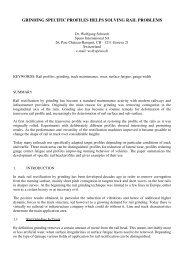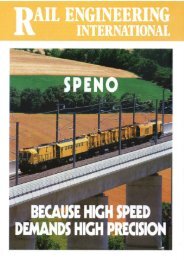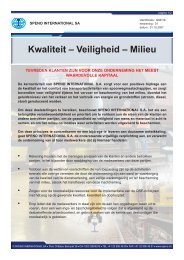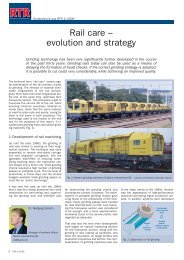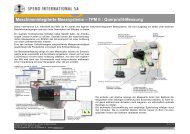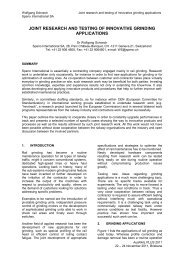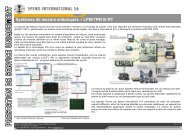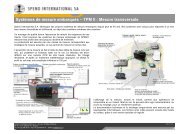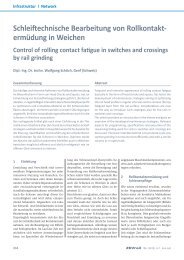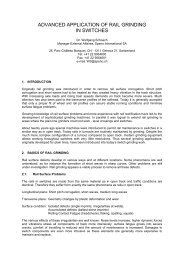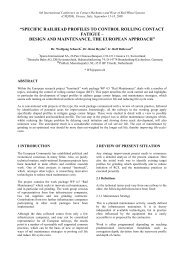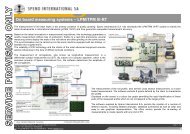Rolling Contact Fatigue mitigation by grinding - speno international sa
Rolling Contact Fatigue mitigation by grinding - speno international sa
Rolling Contact Fatigue mitigation by grinding - speno international sa
Create successful ePaper yourself
Turn your PDF publications into a flip-book with our unique Google optimized e-Paper software.
2.1 Headchecks<br />
In these conditions surface fatigue occurs and fine hairline surface cracks appear. If untreated, the<br />
cracks continue to grow - sometimes outwards to create flaking and spalling, sometimes downwards to<br />
lead to possible rail breakage.<br />
In tangent track the contact zone is situated more or less in the centre of the railhead. Sometimes<br />
isolated surface cracks appear that extend below and parallel to the rail surface. These cracks can<br />
develop into so-called squats or black spots. They may occasionally turn down vertically and finally<br />
result in a complete rail break. When rails are ground in fixed cycles such defects are removed in an<br />
early stage and therefore in principle do not give rise to catastrophic failures.<br />
Figure 1: Headchecks at gauge corner<br />
2.2 Squats<br />
Squats are another effect caused <strong>by</strong> fatigue. Similar to headchecks they appear in tangent track and<br />
very shallow curves anywhere in the contact zone from centre to gauge. Sometimes they are related<br />
to corrugation or imprints on the surface. Looking like a half-circle of v-shaped cracks on the surface<br />
they propagate a few tenths of a millimeter under the surface in the longitudinal direction and turn<br />
occasionally downwards. Due to the subsurface crack the contact zone shifts to either side of the<br />
affected spot, which increases local loading and accelerates further crack growth.<br />
Single squats can be repaired <strong>by</strong> welding. Accumulation of squats requires rail change. Their<br />
occurrence can only be prevented <strong>by</strong> timely removal of the fatigue surface layer <strong>by</strong> <strong>grinding</strong>.<br />
Figure 2: Squats<br />
2.3 Belgrospi<br />
On rails affected <strong>by</strong> short pitch corrugation another fatigue phenomenon has been observed. On the<br />
crests a network of cracks appears, a sort of mixture of irregular headchecks and small squats, with<br />
the <strong>sa</strong>me risk of consequent severe damage. First detected on a German high-speed-line <strong>by</strong> three<br />
engineers named Belz, Grohmann and Spiegel they are known as “Belgrospi’s”. It has been found that




